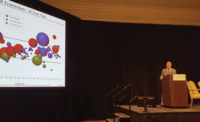What a great thrill it is to have had Milwaukee-based Johnson Controls Inc. accept SDM’s sixth annual Systems Integrator of the Year award for 2009. Johnson Controls is an extensive integrator in the process of spreading its message globally. In fact, when SDM called to tell the firm it had been chosen as the award winner, the Johnson Controls executive team was busy preparing to spend the next two weeks in Asia – with stops in Japan, China, Malaysia and India – to continue their work on deploying the company’s global strategy. From overseas, vice president for Global Security and Fire Safety Solutions, Lisa Roy, shared with SDM her thoughts on the future of the systems integration industry and factors affecting its growth.
SDM: Do you believe the security systems integration industry as a whole is meeting the needs of end users right now?
Roy: From what we have seen, many end users are frustrated with the way security solutions are sold and delivered today. They feel that some product suppliers are pushing their own brand without a detailed understanding of the needs that the end user may have. They feel that some integrators “lock” them into a technology solution that makes them dependent on ongoing license and service fees without good alternative options.
So, to that extent, the industry has some work to do to really meet the core needs of our customers. There has been substantial progress in some areas, however, with new technologies and integrators that are more focused on end-user outcomes.
SDM: What do you think are the major external (outside of the industry) factors propelling growth in the security systems integration industry today? What factors do you think are impeding growth?
Roy: In emerging markets, growth continues to be driven primarily by new construction and the desire for the latest technologies available in the market. In the more mature markets, elevating security to a business asset with measurable business outcomes is an increasingly important market driver. In these markets, we see end users with a traditional view of physical security cutting their budgets. For those end users who consider security as a key element of their business and view it holistically with IT systems and ERP systems, the budgets appear to be going up.
Clearly, the current financial crisis has had a near-term effect on security growth, particularly in the new construction market. Other factors impeding growth include traditional procurement processes that force a narrow view of physical security and reduce its value to an organization.
SDM: How important is open architecture to the future growth of systems integrators?
Roy: Open architecture has many definitions, so let’s look at what benefits the end users. End users want the flexibility to have the best-in-class technologies delivered by the best-in class-integrators, with assurance that they are getting value at a competitive price. They also want their building systems to work together seamlessly to enable high-level applications that have direct impact on their businesses or enterprise. So, we believe that the ability of systems integrators to deliver these benefits to their customers will directly impact their future growth.
SDM: What one thing would you like to see the security systems integration industry do differently?
Roy: Some traditional procurement processes tend to hold back the new collaborative model of security and therefore may delay benefits to some end users. Education and increased visibility of successful best-practice approaches to blending physical security with other building systems and integrated applications would benefit the industry and all who participate.






